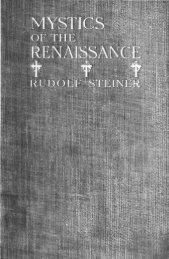The Supreme Doctrine - neo-alchemist
The Supreme Doctrine - neo-alchemist
The Supreme Doctrine - neo-alchemist
Create successful ePaper yourself
Turn your PDF publications into a flip-book with our unique Google optimized e-Paper software.
EMOTION AND THE EMOTIVE STATE<br />
In order to be clear we have, to begin with, thus established our<br />
distinction by means of words of approximate exactitude. We can now be<br />
more precise. <strong>The</strong> phenomenon 'emotion' represents a short-circuit between<br />
the psychic pole and the somatic pole of our organism. One should not speak<br />
in connexion with emotivity, of psychic contraction or of psychic spasm, but<br />
of contraction or spasm of our psycho-somatic organism; the emotional<br />
centre is half-way between the intellectual (or psychic or subtle) centre and<br />
the instinctive (or somatic or gross) centre. Similarly if we spoke at the<br />
beginning of emotions and the emotive state released by images, that is by<br />
psychic, subtle, excitations, we must not forget that our emotivity can equally<br />
be released by somatic, gross, excitations. A somatic indisposition can be the<br />
releasing cause of my gloom, which is an emotive spasm of my psychosomatic<br />
organism. In any case, whether the releasing cause has been psychic<br />
or somatic, the spasm that results always affects both the psyche and the<br />
soma; a certain muscular spasm (of my muscles striated or non-striated)<br />
always accompanies my psychic spasm based on a subconscious image and<br />
vice versa.<br />
Coming back to the idea that emotivity in general represents a shortcircuit<br />
of energy between the intellectual and the instinctive poles, let us see<br />
how, from this point of view, dynamic emotion (we will call it simply<br />
'emotion' in future) is distinguished from the static emotional state (or<br />
emotional state for short). Making use of an electrical comparison one can<br />
say that emotion corresponds with a spark uniting the two poles. This spark<br />
can last for a certain time, but it is not static, for the reason that the contact<br />
which it establishes between the separated poles is a contact in continual<br />
repetition, a contact which shifts; the spark does not simply fly from one pole<br />
to the other, it also flies in a lateral direction. <strong>The</strong> emotive state, on the<br />
contrary, can be compared with a passage of energy which occurs between<br />
the two poles when they touch one another directly along a surface that is<br />
more or less considerable.<br />
This comparison already shows us one of the factors which renders the<br />
emotive state more dangerous than emotion. Emotion, because it shifts, is<br />
visible, conscious; the subject is made aware of it by his inner sensibility; on<br />
account of that diverse defensive mechanisms come into play at once, which<br />
succeed in reducing, then in interrupting, the short-circuit that eats up energy.<br />
On the contrary the emotive state does not give the alarm quickly enough to<br />
the defensive mechanisms; it only gives the alarm tardily, when its<br />
122




